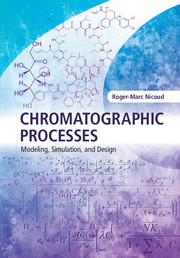Book contents
- Frontmatter
- Contents
- Preface and acknowledgments
- 1 Our approach to modeling chromatographic processes
- 2 Linear chromatography: the Russian Lego
- 3 Non-linear chromatography: equilibrium theory
- 4 Fluid–solid phase equilibria
- 5 Mass transfer
- 6 Hydrodynamics of chromatographic columns
- 7 Simulating chromatographic columns
- 8 Counter-current systems
- 9 Chromatographic modes and their optimization
- 10 Addressing a few industrial problems
- 11 Conclusion
- Appendix A Some important properties of the Laplace transform
- Appendix B Inlet and outlet boundary conditions
- Appendix C Equilibrium theory: single-solute chromatograms
- Appendix D Equilibrium theory: binary chromatograms
- Appendix E The influence of the porosity determination on chromatographic modeling
- Appendix F Useful physico-chemical data and orders of magnitude
- Appendix G Fick and Maxwell–Stefan approaches to diffusion
- Appendix H Non-linear LDF for multi-solute systems
- Appendix I Situations that make the use of the MC model problematic
- Appendix J Typical industrial chromatographic processes
- Notation
- Index
- References
3 - Non-linear chromatography: equilibrium theory
Published online by Cambridge University Press: 05 April 2015
- Frontmatter
- Contents
- Preface and acknowledgments
- 1 Our approach to modeling chromatographic processes
- 2 Linear chromatography: the Russian Lego
- 3 Non-linear chromatography: equilibrium theory
- 4 Fluid–solid phase equilibria
- 5 Mass transfer
- 6 Hydrodynamics of chromatographic columns
- 7 Simulating chromatographic columns
- 8 Counter-current systems
- 9 Chromatographic modes and their optimization
- 10 Addressing a few industrial problems
- 11 Conclusion
- Appendix A Some important properties of the Laplace transform
- Appendix B Inlet and outlet boundary conditions
- Appendix C Equilibrium theory: single-solute chromatograms
- Appendix D Equilibrium theory: binary chromatograms
- Appendix E The influence of the porosity determination on chromatographic modeling
- Appendix F Useful physico-chemical data and orders of magnitude
- Appendix G Fick and Maxwell–Stefan approaches to diffusion
- Appendix H Non-linear LDF for multi-solute systems
- Appendix I Situations that make the use of the MC model problematic
- Appendix J Typical industrial chromatographic processes
- Notation
- Index
- References
Summary
Sort of a naked version of chromatography ‖
Introduction
The previous chapters introduced fundamental principles assuming that chromatographic processes can be described as linear systems. However, most if not all industrial chromatographic systems are non-linear due to the high concentrations applied there. Addressing the key consequences of non-linearity is the objective of this chapter.
Non-linear phenomena can arise from several sources including the nature of the distribution equilibria of the solutes between phases, chemical reactions or equilibria in the column, solubility limitations, sorption effects in gas chromatography and viscosity effects in liquids. We will speak of thermodynamic non-linearity later on; this chapter will stress the fundamental difference between the effects of thermodynamics and kinetics on the shape of chromatograms.
In this chapter we will restrict our study to the influence of essential features of fluid–solid equilibria (specifically adsorption isotherms) because this is usually the main reason for non-linearity in chromatography. Just as “linear chromatography” refers to systems with linear lumped adsorption isotherms in Chapter 2, “non-linear chromatography” refers to non-linear lumped adsorption isotherms in this chapter.
Non-linearity gives rise to various intriguing phenomena and sometimes non-intuitive behavior of chromatographic processes. Well-known effects are peak tailing and fronting, which are related to the formation of self-sharpening and self-broadening fronts (another frequent term is compressive and dispersive waves). While peak tailing and fronting are already observed in single-solute systems, more complex situations can arise when separating mixtures, for instance, so-called displacement (a strongly retained solute pushing and concentrating less-retained solutes) and tag-along (appearance of long plateaus of the more retained species) effects, and system peaks (extraneous peaks not directly associated with a species contained in the feed).
In order to extract the essence of thermodynamic non-linearity we will assume a column of infinite efficiency in which neither hydrodynamic dispersion nor kinetic limitation occurs. Using the terminology introduced in Chapters 1 and 2, this means that the number of mixing cells (J), the number of plates (N) and the Péclet number (Pe) all equal infinity.
- Type
- Chapter
- Information
- Chromatographic ProcessesModeling, Simulation, and Design, pp. 62 - 138Publisher: Cambridge University PressPrint publication year: 2015

